- HubPages»
- Travel and Places»
- Visiting Asia»
- Southern Asia
The Underground Limestone Caves of Ekiriya Village
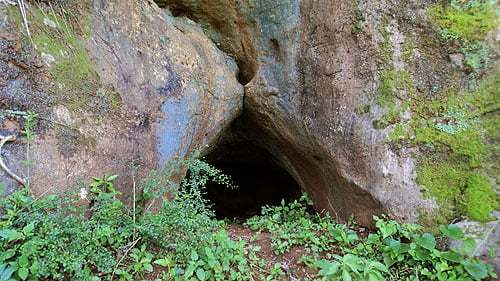
The descent into "Total Darkness"
Ekiriya is a small village in Nuwara Eliya District, in the Central Province of Sri Lanka. Until Priyanka, my traveller-friend brought the news that there are subterranean limestone caves somewhere in Ekiriya, I never thought I would be able to witness another of the kind like the Wavulpane limestone caves in Sabaragamuwa Province, which is currently the most famous of the kind in the country. Priyanka and I descended into the large limestone cave system of Ekiriya 10 years ago. I thought of going down into them again for the pleasure of the Hub readers, and Priyanka was back with me!
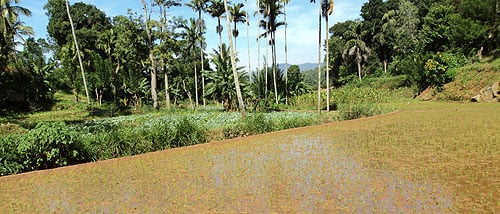
One fine early morning, I set off with Priyanka from Kandy to visit the Ekiriya caves. Priyanka rode his motocycle along B413 (Tennekumbura-Rikillagaskada-Ragala) Road, and about 1½ hours later we were at Rikillagaskada. From there we had to ride a few hundred meters to reach the Poramadulla junction to turn to the Poramadulla-Palle Bowala Road. We passed the Poramadulla Central College and rode for another couple of kilometers to reach Ekiriya, the beautiful village which was sitting over a 1500 million years old Pre-Cambrian limestone cave system. Ekiriya is a village beautified by its vast paddy and vegetable cultivations on the undulating terrain of the Central Province of Sri Lanka. It is gifted with the natural water sources bubbling out from the springs deep inside the underground limestone caves. Spring water streams flow along the contours of the land, giving life to the people, animals and the cultivation.
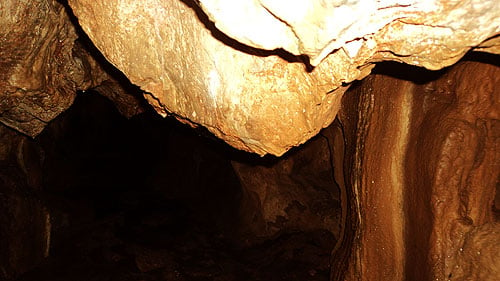
The Origin of Limestone Caves
Limestone caves are formed by dissolving the underground limestone, or Dolomite bedrocks by the natural acidity that occur in groundwater. The subterranean spring water can naturally contain carbonic, sulfuric and other organic acids. When water tries to flow through these limestone rocks which contain Calcite and Dolomite, the acids in the water will react with the stone and produce soluble salts containing Calcium, Magnesium, and Bicarbonate ions. The resultant salts are continuously washed away by the water creating catacombs within the bedrock. This process had been going on for millions of years to create a system of underground caves and connecting tunnels until they are now big enough to be accessible by human beings.
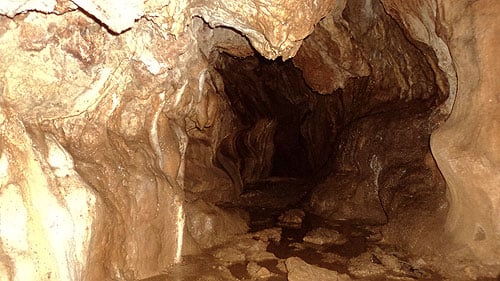
Back to the Journey...
We passed a long stretch of paddy fields and crossed a small stream. The stream looked so fresh. Villagers had a bathing spot built by damming the natural stream with granite blocks and letting the water to flow out from pipes fixed to it. People stood under these pipes to bathe the cool water. We headed towards the underground cave from where the stream is coming!
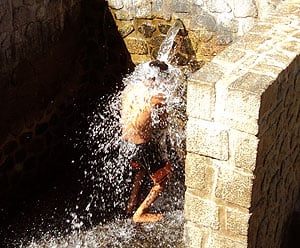
We found the entrance to the underground cave. It was weather-split huge rock. My traveller-friend Priyanka asked me to follow him and started creeping through the split of the rock in crab-style. I followed. A few bats flew away from inside the cave, fanning wind on my face. After a few feet of difficult creeping the way extended to a space big enough for us to walk. It was too dark, so I flashed the torch. We saw that we were on the edge of a hole, roughly a little wider than a manhole. It was too dark to see what was in it. But I could hear the sweet melody of flowing water from the deep end of the hole.
In The Subterrainean Waterway
"I'll go first..", said Priyanka, and held the edges of the hole by his hands and put his legs down into it. I could not see him for a while. Then a torch flashed from down towards the manhole, and Priyanka called, "Come, its fantastic down here...!"
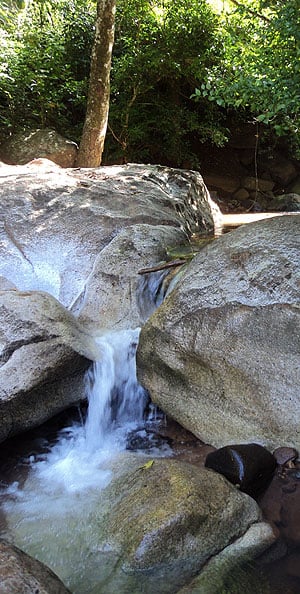
I descended through the hole, just as Priyanka did. When I let myself lower down, I felt the stream of cold water washing my feet. Then I let myself fall, about two feet, and found standing in the underground stream. Priyanke flashed the torch and lead the way through the tunnel. After a few meters we entered a huge cave space about ten meters high. There were places on the cave roof from where drops of water leaked down into the cave and joined the little streams draining from its walls to join the main flow of water.
Stalactites and Stalagmites
The cave was full of stalactites and stalagmites. Stalactites are the limestone columns that hang from the cave roof. Stalagmites too are such columns that grow upwards, right underneath the Stalactites. Both these formations are commonly called speleothems. These are the results of limestone solution by dripping water. Depending on the solution rate of the bedrock, the growth of these speleothems can vary from 0.5 inch to 3 inches per year.

We spent about 2-3 hours exploring the caves and came out. It was great having a bath in the bathing spot built by the villagers. We stopped to have a chat with a 12-year old village boy who had an interest in the limestone caves. He said about a lot of such caves spreading throughout the village. Obviously, they too are parts of the same cave system. We wondered how big the entire catacomb can be. It is marvelous to think that the village of Ekiriya is sitting on it!
The article on Ekiriya I published 10 years ago...
I published an article on Ekiriya Caves just after my first descent there. It was hosted in www.kothmale.org which was a UNESCO project then. Now, it is under the administration of Sri Lanka Broadcasting Corporation, and the article is no more at that location.
Thanks to networkedblogs.com. They have re-published that article. If you wish to read about my first visit to Ekiriya, you may visit http://networkedblogs.com/l2Bay.








